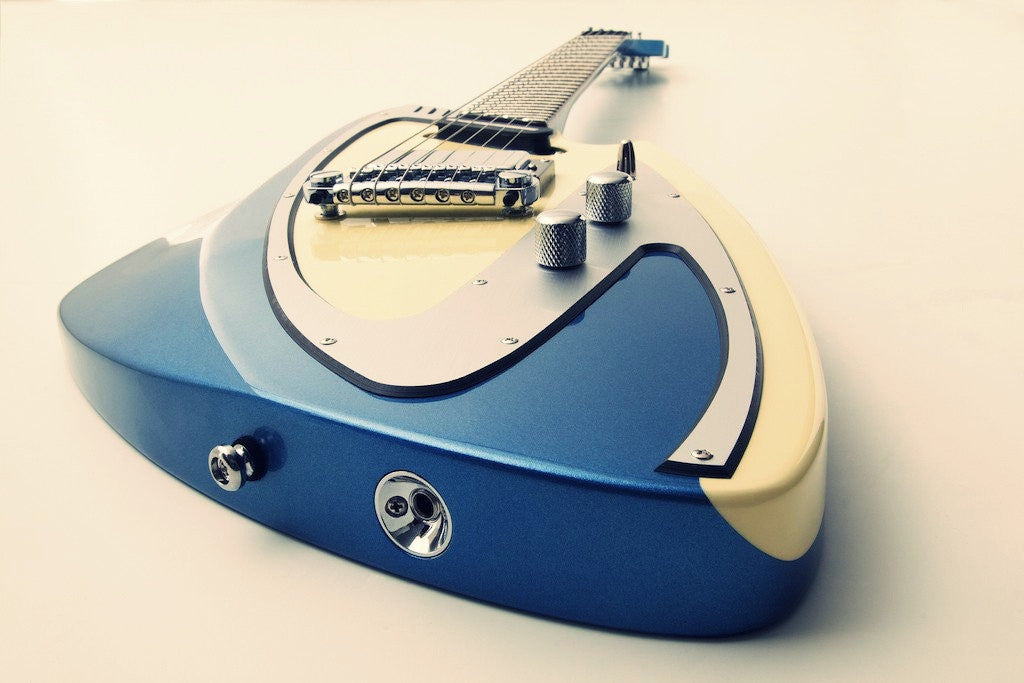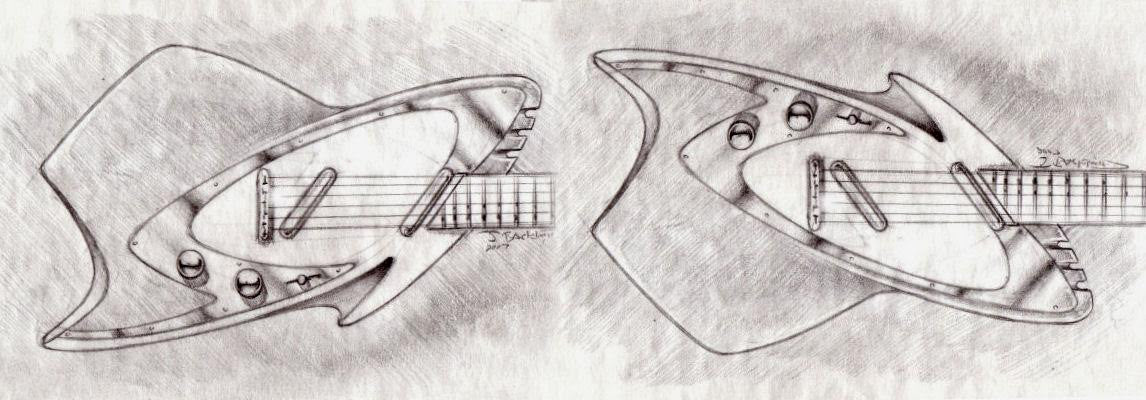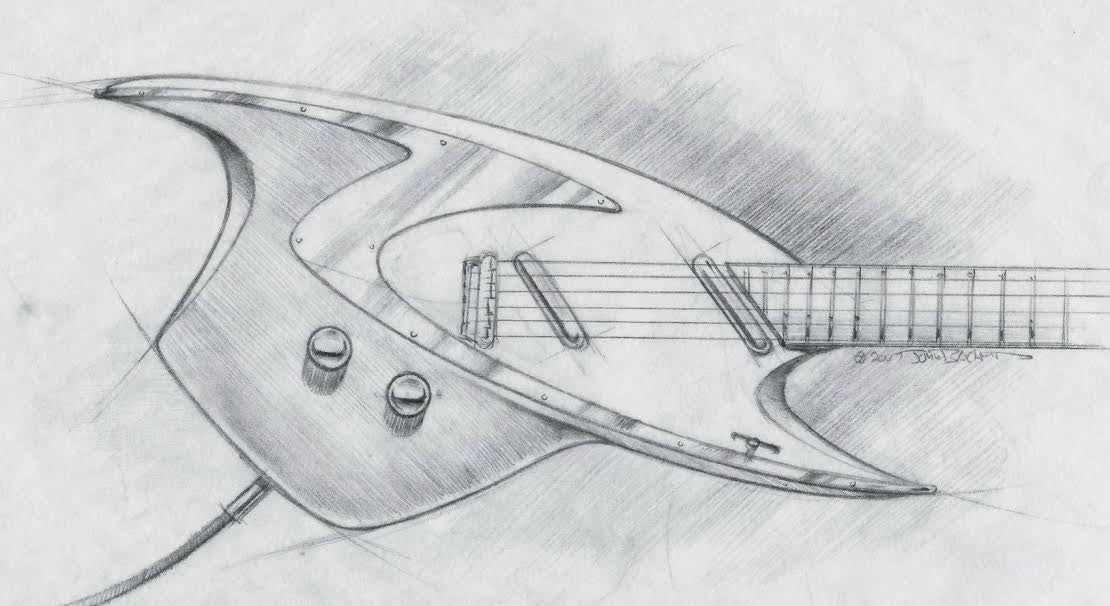Behind the scenes with... John Backlund
Backlund guitars are new classics - iconic, "retro futuristic" designs that hark back to another era, but also hint at the future. We had a chat with John Backlund, the creator of our upcoming Custom Shop Model 400 and other great guitars...

John Backlund at his working desk
John Backlund is a classic American entrepreneur, the likes of which we don't see that often anymore: driven and creative, who puts his dreams to paper and then turn them into reality.
His guitars have the same spirit that's reminiscent of those classic post-war years that made American arts & culture such an inspiration and influence worldwide, from Leo Fender guitars to Ford cars, from Frank Lloyd Wright creations to a myriad of films, books and music still considered classics today: a sense of freedom, creativity and even optimism - because always looking at the future, trying to create something new.
When you pick up a Backlund guitar, you can imagine how people felt when grabbing one of those now-classic guitars, like a Strat, when they were brand new, in the 1950s... and you can be sure that your Backlund guitar will, like those classic designs from the past, still feel modern and current in 40, 50 years time!

The Backlund Model 100, one of John Backlund's stunning creations.
Do we sound a bit over-the-top? Maybe... but if you ever played a Backlund, you'll probably agree with us! That's why here at Eastwood we're all very excited to be releasing the new Eastwood Custom Shop Backlund 400, perhaps his coolest design yet, which has been fully funded and will be hitting the shops later this year.
(editor's note: The Backlund 400 has since been discontinued [9.8.21])

John Backlund: a quick background
According to his official website, John is a self-taught artist/designer, influenced by retro-futuristic design concepts that are reminiscent of the period from the mid-late 1930's to the early 1960's. The terms "Aero," "Rocket," "Streamline," and even "Atomic" are often used to describe his design work.
John has often found himself involved in pursuits besides art and design, including stints as a reluctant motorcycle salesman, a rather terrible guitar salesman, a very young and inept Nebraska sandhills ranch hand, and a fairly good flatbed semi-driver running a worn-out Freightliner FLD throughout the Midwest.
Reflecting on guitars and design, John observed, "I like color in my designs. I like bright things. I like two-tones that compliment each other. I like a splash of chrome for contrast, and I like it all integrated into a flowing form that is 'balanced,' well-proportioned, and pleasing to the eye. Solidbody electric guitars are a tempting and wonderful candidate for my style of design, and being a guitar player for many decades, it's only natural that they figure prominently in my efforts."
Exclusive Eastwood interview with John Backlund
Prior to the release of our new Backlund 400, we had a chance to have a quick chat with John Backlund, to learn a bit more about himself, his thoughts about guitars and how he came up with his designs. A fascinating insight into a truly innovative designer! Enjoy...
Why and how did you become a guitar designer?
John Backlund: I've always been attracted to the industrial design of the the mid-1930's through early 1960's, especially in consumer goods, automobiles of course, but even the more mundane everyday items such as kitchen appliances often showed a level of style that went far beyond simple functionality. I've been involved with guitars as a casual player since the late 1960's, and have spent most of my professional life as an illustrator and graphic artist, and around 2004-2005, the planets must have lined-up just right, and I began to apply my interest in those now 'retro' industrial design elements of the mid-century past, along with my illustrative talents, to create a series of guitar designs that I personally would have liked to own. It was quite a private undertaking at first, with little if any thought to ever seeing them actually made, much less offered to the guitar-playing community as production instruments.
My first efforts were small pencil concept sketches, usually on bond paper, they were no more than two or three inches in length. I was a member of the Harmony Central Guitar Forum at the time, and posted a number of my concept sketches in the Electric Guitar forum to get the member's reaction to them, which ran the gamut of high praise and enthusiasm, to derision and things like "Yuk!", but that's all part of it, and I learned early on that one person's work of 'playable art' is another person's 'ugly piece of crap'. Fortunately, the positives generally far outweighed the negatives.
Your designs seem to tap into the same sources as those original Leo Fender designs, even though the results are totally different: very modern, very American, very dynamic, very original... do you see those similarities?
I've never been comfortable with the term 'designer' as it applies to guitars, and feel that I'm more of a 'stylist'. None of my guitars really break new ground in any technical sense, they are not innovative technically, just have a different 'look'. My usual analogy is that I'm not trying to re-invent the wheel, I just want to put a big whitewall and an attractive hubcap on the old one. Leo Fender was much more of a technician than I am, and knew his guitars 'in and out', I generally only know the 'out' of my guitars, relying on the expertise of others, knowledgeable in guitar construction to bring them into the world as viable, quality, instruments.
Most of my guitar designs aren't usually described as 'modern' in appearance, but represent a mythical futurism as seen from the past, or as it's often called: 'retro-futuristic'. They are 'American' in the sense that they are often seen as being reminiscent of American automotive stylings from the 40's through about the early 60's by the use of two-tone colors and the treatment of cosmetic metal parts, as well as general outline and contoured body profiles that are automotive/aviation influenced.
The reaction to our custom shop Backlund 400 has been great so far - what inspired you to create this particular design?
The 400 was a fortunate accident, I was working on a pencil sketch of a guitar idea that wasn't going all that well, when just for kicks, I inverted the image on the computer an immediately saw what could be, with a little more work, a quite attractive guitar, and one that was a bit of a departure from what I was working on at the time, being a little, as they say, 'pointy', yet retained a measure of ' smoothness of line' that I liked.

The 400 headstock however, was a different matter. I never got around to coming up with a fitting headstock for the 400, and it existed only as a body shot concept until the J. Backlund Design Co., who wanted to build the 400 as a boutique custom guitar, 'borrowed' the rather odd headstock from another of my concepts at the time, the model 1000, and applied it to the 400, which I must admit, worked quite well.

Only five, or possibly six U.S.-built model 400's were ever made, and at a price of $4000+ they remained a very exclusive and rare instrument. I own 400 #4, as well as an illegal Chinese knockoff that I was able to purchase several months ago. Fortunately, it is the only one that they made. Its build-quality is quite poor, but it's a fascinating side-note to the history of the model 400.
Do you think electric guitars will ever become obsolete or unfashionable?
I imagine that technology will (continue to) create musical instruments that will not require the commitment in time and effort that a conventional stringed guitar does to play well, but people still paint scenes with oils and watercolors that they could have simply snapped an image of with their phones and went home, so I'm not going to concern myself very much about guitars becoming obsolete, they'll never be able to replace the deep sense of personal accomplishment that comes from playing a great song with bleeding fingers.
What is the single, most important thing that makes a guitar 'great'?
My first impulse it to say 'the player', assuming that the instrument being played meets a certain minimum criteria of 'playability' of course. I consider my old MIM Telecaster a great, no 'BS', sound-making monster, and it must be, if it can help ME sound good. I love its classic simplicity and lack of superfluous embellishments and frills, even though it's what many would feel is the complete opposite of the kind of guitars that I've designed.
- by Ivan S.


